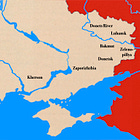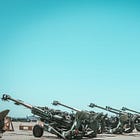Where are the Fighter Drones?
A speculation
The small, short-range unmanned aerial vehicles so much in evidence in the present war in Ukraine resemble the manned aeroplanes of the first few months of the First World War. Like the flying machines of the magnificent men of 1914, these fragile contraptions serve chiefly as engines of reconnaissance. That is, while capable of other things, drones of the hand-held persuasion spend most of their time aloft either scouting ahead of friendly forces, surveilling pieces of ground, or spotting for artillery.
In the First World War, it did not take long for aviators to look for ways of depriving the enemy of his ‘eyes in the sky’. Thus, even the appearance, in 1915, of purpose-built fighter planes, the fly-boys on either side began to shoot at each other, at first with pistols and rifles, and then with jury-rigged machine guns.
If this analogy holds, then we should soon see drones of the smaller sort engage each other in aerial combat. Indeed, I suspect that the only thing that has prevented such battles in the sky is the difficulty of finding, and fitting, suitable weapons.
Any engineer who tried to equip a hand-held drone with a firearm would have to find some way of managing the recoil. (Isaac Newton … Sir Isaac Newton … please call your answering service.) Thus, flying robots armed with guns would, in all likelihood, have to be much larger than drones employed to examine the other side of the hill.
This consideration, I suspect, would incline the makers of military drones to two courses of action. The easiest would be the conversion of reconnaissance drones into suicide planes. (The simplest of these would attempt to ram their victims. Fancier models would carry explosives.)
The proliferation of drones designed to explode in the sky would create incentives for the creation of what might be called Kevorkians. Such devices would use a variety of means, electronic and otherwise, to encourage the precocious self-slaughter of suicide drones.
Other armed drones, smaller than the gunships but bigger than the one-and-done machines, would carry guided missiles. In some cases, the flight of such missiles would be guided by the joystick of the drone operator. In others, it might make use of some sort of algorithm.
In the ongoing war in Ukraine, the Russians are making extensive use of jamming, mimicry, and other tools of electronic warfare to deprive Ukrainian drone handlers of the ability to control their robots. Moreover, I would be very surprised if they were not already hard at work at devices that would allow them to hijack drones belonging to their enemies.
Because of the prospect of such exercises in aerial piracy, I suspect that we will soon see the replacement of man-in-the-loop drones with small flying robots that, guided by a simple set of rules, direct their own actions. (Isaac Asimov … Professor Isaac Asimov … please call your answering service.)
One of the first tricks taught to self-directed flying robots will have much in common with the algorithm that allows recently-minted cars to park themselves. That is, this bit of software will allow drones to take refuge from hostile counterparts by ‘parking’ themselves under trees, in tall grass, or the shadows of buildings. (The clever drones might even be able to move in response to the shifting of the shade that protects them from prying eyes.)
As ever-increasing numbers of drones practice Auftragstaktik, those who would deprive them of their power (or, better yet, turn them against their masters) will make use of ‘pattern-spoofing’. That is to say, they will use a variety of means to create scenes that convince hostile drones to act in ways that make them less useful (or, better yet, downright dangerous) to their masters.
For Further Reading:
To Share, Subscribe, or Support:









I really like that idea, “dangerous to their masters.” Let’s do that one.
I doubt the ability of engineers to come up with a workable system of automated drones to kill combatants, due to a few key parts.
Lack of understanding of how to design a 'bird' like device that knows what to kill when to kill and do so effectively without blue on blue occuring
Reduction in total number of educated professionalals needed to start such projects
The reality that the logistics of such devices would be nigh-um impossible to source reliably en mass for and from one nation/ place (supply chain would be global as a result subject to all pros and cons)
The harshest reality that a more technically advanced society, or in this case military, actually has a higher demand on the number of men employed to produce, maintain and broadly use the devices, thereby defeating the point of the intended theoretical benefits of drones in the military.